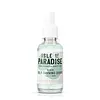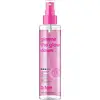What's inside
What's inside
 Key Ingredients
Key Ingredients

 Benefits
Benefits

 Concerns
Concerns

 Ingredients Side-by-side
Ingredients Side-by-side

Water
Skin ConditioningDihydroxyacetone
Skin ConditioningAlcohol Denat.
AntimicrobialGlycerin
HumectantPolysorbate 80
EmulsifyingXanthan Gum
EmulsifyingErythrulose
TanningPropylene Glycol
HumectantTropaeolum Majus Flower/Leaf/Stem Extract
Skin ConditioningTocopheryl Acetate
AntioxidantAloe Barbadensis Extract
Skin ConditioningCitrus Grandis Peel Oil
MaskingCocos Nucifera Oil
MaskingEucalyptus Globulus Leaf Oil
PerfumingMentha Piperita Oil
MaskingPersea Gratissima Oil
Skin ConditioningSalvia Hispanica Seed Oil
MoisturisingSalvia Officinalis Oil
MaskingMethoxyphenyl T-Butylphenyl Propanediol
Skin ConditioningAgastache Mexicana Flower/Leaf/Stem Extract
Skin ConditioningAscorbic Acid
AntioxidantPropanediol
SolventEthylhexylglycerin
Skin ConditioningSodium Metabisulfite
AntioxidantParfum
MaskingSodium Hydroxide
BufferingPhenoxyethanol
PreservativeTriethylene Glycol
MaskingWater, Dihydroxyacetone, Alcohol Denat., Glycerin, Polysorbate 80, Xanthan Gum, Erythrulose, Propylene Glycol, Tropaeolum Majus Flower/Leaf/Stem Extract, Tocopheryl Acetate, Aloe Barbadensis Extract, Citrus Grandis Peel Oil, Cocos Nucifera Oil, Eucalyptus Globulus Leaf Oil, Mentha Piperita Oil, Persea Gratissima Oil, Salvia Hispanica Seed Oil, Salvia Officinalis Oil, Methoxyphenyl T-Butylphenyl Propanediol, Agastache Mexicana Flower/Leaf/Stem Extract, Ascorbic Acid, Propanediol, Ethylhexylglycerin, Sodium Metabisulfite, Parfum, Sodium Hydroxide, Phenoxyethanol, Triethylene Glycol
Water
Skin ConditioningAlcohol Denat.
AntimicrobialDihydroxyacetone
Skin ConditioningEthoxydiglycol
HumectantPropylene Glycol
HumectantPolysorbate 20
EmulsifyingCaprylyl Glycol
EmollientPotassium Sorbate
PreservativeHexylene Glycol
EmulsifyingXanthan Gum
EmulsifyingRosa Damascena Flower Water
MaskingArgania Spinosa Kernel Oil
EmollientCocos Nucifera Oil
MaskingCucumis Sativus Seed Oil
EmollientMacadamia Integrifolia Seed Oil
Skin ConditioningPersea Gratissima Oil
Skin ConditioningRosa Canina Fruit Oil
EmollientSimmondsia Chinensis Seed Oil
EmollientVitis Vinifera Seed Oil
EmollientPhenoxyethanol
PreservativeAscorbic Acid
AntioxidantTocopheryl Acetate
AntioxidantCitric Acid
BufferingParfum
MaskingCI 17200
Cosmetic ColorantWater, Alcohol Denat., Dihydroxyacetone, Ethoxydiglycol, Propylene Glycol, Polysorbate 20, Caprylyl Glycol, Potassium Sorbate, Hexylene Glycol, Xanthan Gum, Rosa Damascena Flower Water, Argania Spinosa Kernel Oil, Cocos Nucifera Oil, Cucumis Sativus Seed Oil, Macadamia Integrifolia Seed Oil, Persea Gratissima Oil, Rosa Canina Fruit Oil, Simmondsia Chinensis Seed Oil, Vitis Vinifera Seed Oil, Phenoxyethanol, Ascorbic Acid, Tocopheryl Acetate, Citric Acid, Parfum, CI 17200
 Reviews
Reviews

Ingredients Explained
These ingredients are found in both products.
Ingredients higher up in an ingredient list are typically present in a larger amount.
Alcohol Denat. is an alcohol with a denaturant property. It is created by mixing ethanol with other additives.
This ingredient gets a bad rep because it is irritating and drying - mostly due to its astringent property. Astringents draw out natural oils in tissue, constricting pores and leaving your skin dried out.
However, alcohol denat. is not all that bad.
Due to its low molecular weight, alcohol denat. tends to evaporate quickly. One study on pig skin found half of applied alcohol evaporated in 10 seconds and less than 3% stayed on skin.
This also helps other ingredients become better absorbed upon application.
Studies are conflicted about whether this ingredient causes skin dehydration. One study from 2005 found adding emollients to propanol-based sanitizer decreased skin dryness and irritation. Another study found irritation only occurs if your skin is already damaged.
Small amounts of alcohol are generally tolerated by oily skin or people who live in humid environments.
The rule of thumb is if this alcohol is near the end of an ingredients list, it will probably not affect your skin much.
Also...
This ingredient has antimicrobial and solvent properties.
The antimicrobial property helps preserve products and increase their shelf life. As a solvent, it helps dissolve other ingredients.
Other types of astringent alcohols include:
Learn more about Alcohol Denat.Ascorbic Acid is is pure Vitamin C. This form makes up the largest amount of vitamin C found naturally in our skin.
Not only is vitamin C great for your overall health and immune system, it also has plenty of benefits on your skin.
Vitamin C is best used for brightening skin. It improves dark spots, acne scars, and hyperpigmentation. This is because it blocks the process of skin darkening when exposed to UV.
Remember: Vitamin C should not replace sunscreen!
Your skin uses vitamin C to build collagen. Collagen is one key component in having a strong skin barrier and plump skin. Vitamin C also plays a role in regulating collagen, thus making it effective in improving wrinkles and fine lines.
Ascorbic acid shows potent antioxidant activity. As an antioxidant, it helps fight free-radicals. Free-radicals are molecules that may damage your skin cells. These antioxidants also protect skin against UV damage.
The best formulations include Vitamin E and/or ferulic acid. These two ingredients help stabilize and provide a boost in the benefits of ascorbic acid. This is because ascorbic acid becomes unstable when exposed to UV and air. In fact, you can tell your ascorbic acid has oxidized when it turns an orange-yellow color.
Ascorbic acid is generally compatible with other ingredients. However, using ascorbic acid with other active ingredients might cause irritation. Two ingredients: copper ions and benzoyl peroxide, will inactivate ascorbic acid completely.
Read more about other types of Vitamin C:
Foods rich with vitamin C include oranges, strawberries, broccoli, bell peppers, and more. When consuming Vitamin C, your skin receives a portion of the nutrients.
Learn more about Ascorbic AcidCocos Nucifera Oil is obtained from the kernels of the coconut fruit. In other words, this is coconut oil.
Coconut Oil is rich in fatty acids with lauric acid making up the majority of these. It also contains linoleic acid. Due to this high fatty acid content, coconut oil helps trap moisture and soften skin.
Despite being antibacterial, coconut oil may not be great for acne-prone skin. It is comedogenic and may clog pores. This ingredient may not be safe for malassezia or fungal acne.
Note: Coconut Oil should not replace your sunscreen for UV protection. Studies show it only blocks about 20% of UV.
This oil is non-volatile and has a light scent.
The term 'fragrance' is not regulated in many countries. In many cases, it is up to the brand to define this term. For instance, many brands choose to label themselves as "fragrance-free" because they are not using synthetic fragrances. However, their products may still contain ingredients such as essential oils that are considered a fragrance.
Learn more about Cocos Nucifera OilDihydroxyacetone, or DHA, is a simple sugar. It is frequently used in self-tanning products.
DHA binds to the amino acids in your dead skin cells to create a brown/orange color. Darkening begins to kick in a few hours after application and will continue to develop for up to 3 days. This ingredient can be drying.
Both the US and the EU have approved DHA in self-tanning products. In the EU, DHA is allowed at a maximum concentration of 10%. Most tanning products usually contain amounts between 3-5%.
If you are pregnant or have underlying medical conditions, it is best to speak with a dermatologist about using self-tanning products.
Learn more about DihydroxyacetoneParfum is a catch-all term for an ingredient or more that is used to give a scent to products.
Also called "fragrance", this ingredient can be a blend of hundreds of chemicals or plant oils. This means every product with "fragrance" or "parfum" in the ingredients list is a different mixture.
For instance, Habanolide is a proprietary trade name for a specific aroma chemical. When used as a fragrance ingredient in cosmetics, most aroma chemicals fall under the broad labeling category of “FRAGRANCE” or “PARFUM” according to EU and US regulations.
The term 'parfum' or 'fragrance' is not regulated in many countries. In many cases, it is up to the brand to define this term.
For instance, many brands choose to label themselves as "fragrance-free" because they are not using synthetic fragrances. However, their products may still contain ingredients such as essential oils that are considered a fragrance by INCI standards.
One example is Calendula flower extract. Calendula is an essential oil that still imparts a scent or 'fragrance'.
Depending on the blend, the ingredients in the mixture can cause allergies and sensitivities on the skin. Some ingredients that are known EU allergens include linalool and citronellol.
Parfum can also be used to mask or cover an unpleasant scent.
The bottom line is: not all fragrances/parfum/ingredients are created equally. If you are worried about fragrances, we recommend taking a closer look at an ingredient. And of course, we always recommend speaking with a professional.
Learn more about ParfumPersea Gratissima Oil is also known as avocado oil.
Avocado Oil has antioxidant properties. It is mostly made up of the glycerides of fatty acids. About 67% of these fatty acids is made up of oleic acid. Palmitic acid and linoleic acid are also present.
These fatty acids help hydrate and soften the skin. It may increase collagen content in the skin. Collagen helps keep your skin plump and firm. This ingredient helps reduce inflammation and has not shown to clog pores.
This ingredient may not be fungal-acne safe due to its high fatty acid content.
Avocados also have B vitamins, vitamin K, vitamin C, vitamin E, and potassium.
Learn more about Persea Gratissima OilPhenoxyethanol is a preservative that has germicide, antimicrobial, and aromatic properties. Studies show that phenoxyethanol can prevent microbial growth. By itself, it has a scent that is similar to that of a rose.
It's often used in formulations along with Caprylyl Glycol to preserve the shelf life of products.
Propylene Glycol is an odorless, colorless liquid. As a humectant, it helps skin retain moisture. It also aids in delivering active ingredients.
Another role of this ingredient is preventing a product from melting or freezing. Propylene glycol also adds antimicrobrial properties to a product, elongating product lifespan.
This ingredient is considered an organic alcohol and commonly added into both cosmetics and foods.
Those with sensitive skin or conditions may develop a rash when using this ingredient.
Learn more about Propylene GlycolTocopheryl Acetate is AKA Vitamin E. It is an antioxidant and protects your skin from free radicals. Free radicals damage the skin by breaking down collagen.
One study found using Tocopheryl Acetate with Vitamin C decreased the number of sunburned cells.
Tocopheryl Acetate is commonly found in both skincare and dietary supplements.
Learn more about Tocopheryl AcetateWater. It's the most common cosmetic ingredient of all. You'll usually see it at the top of ingredient lists, meaning that it makes up the largest part of the product.
So why is it so popular? Water most often acts as a solvent - this means that it helps dissolve other ingredients into the formulation.
You'll also recognize water as that liquid we all need to stay alive. If you see this, drink a glass of water. Stay hydrated!
Learn more about WaterXanthan gum is used as a stabilizer and thickener within cosmetic products. It helps give products a sticky, thick feeling - preventing them from being too runny.
On the technical side of things, xanthan gum is a polysaccharide - a combination consisting of multiple sugar molecules bonded together.
Xanthan gum is a pretty common and great ingredient. It is a natural, non-toxic, non-irritating ingredient that is also commonly used in food products.
Learn more about Xanthan Gum